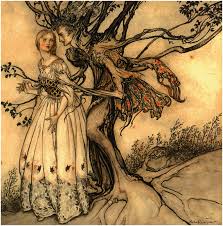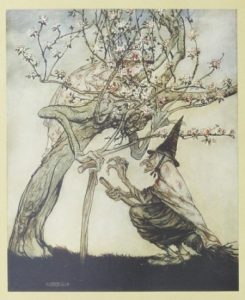In response to Kaja’s entertaining and informative post about trolls comes this picture which I love from Grimm’s Fairy Tales, published by Constable in 1909. A wonderful example of one of Rackham’s anthropomorphic trees which has some similarities to the Norwegian troll illustration by Nikolai Astrup that was mentioned.
There is also this troll tree by Rackham from English Fairy Tales (1918).
I am working on a post on Puck so more soon on fairy folk and fairy courts from A Mid Summer Night’s Dream to contemporary YA fiction. Let us know your troll texts in the meantime. Let’s continue to celebrate the troll!
Discover more from Open Graves, Open Minds
Subscribe to get the latest posts sent to your email.



These pictures remind me a little of Ents in Tolkien’s novels. From what I can remember, the Ents and their engagement in the battle against Saruman and the consequent destruction of Isengard can be read as a metaphor for the revenge of the ancient natural world against new technologies, and Tolkien’s dislike of what we now call ‘big industry’ and the latter days of the industrial revolution. I think it’s quite interesting that the trolls I talked about are increasingly used as symbols of the ancient, natural spirit of the place and the are part of environmental narratives. With their ability to evoke childhood innocence and their tricksy non-human ethics, fey creatures seem to be perfect emblems of the natural world.
These ideas also reminded me of some lines from Tony Harrison’s ‘A Kumquat for John Keats’ (1981):
‘And it isn’t just the gap of sixteen years,
a bigger crop of terrors, hopes and fears,
but a century of history on this earth
between John Keats’s death and my own birth-
years like an open crater, gory, grim,
with bloody bubbles leering at the rim;
a thing no bigger than an urn explodes
and ravishes all silence, and all odes,
Flora asphyxiated by foul air
unknown to either Keats or Lempriere,
dehydrated Naiads, Dryad amputees
dragging themselves through slagscapes with no trees,
a shirt of Nessus fire that gnaws and eats
children half the age of dying Keats . . .’
Similarly classical creatures of nature are destroyed by new, violent technologies. Both Holly Black and Julie Kagawa draw on the enmity between iron and the fey to great affect using these ideas. The idea of demystifying and removing the magic from the experience of nature is a really intriguing theme.
Hi,
Yes I do post up some of these pics when we study ‘The Iron King’ to talk about the fey and the natural world but I had not thought of using the Harrison poem. It is very powerful. I am a fan too (because of the Northern dialect). The woodland spirits and fairy courts are a fantastic way of introducing these ideas and getting the students to try out some eco-critical and eco-gothic readings. There is a lot about metaphors of belief in Kagawa and others too i. e. if we do not believe or no longer have the knowledge of the folklore the fey and fairies will disappear from our woodlands. Something that J. M. Barrie was aware of in the creation of Tinkerbelle….whereby something dies everytime a child says they do not believe in fairies….